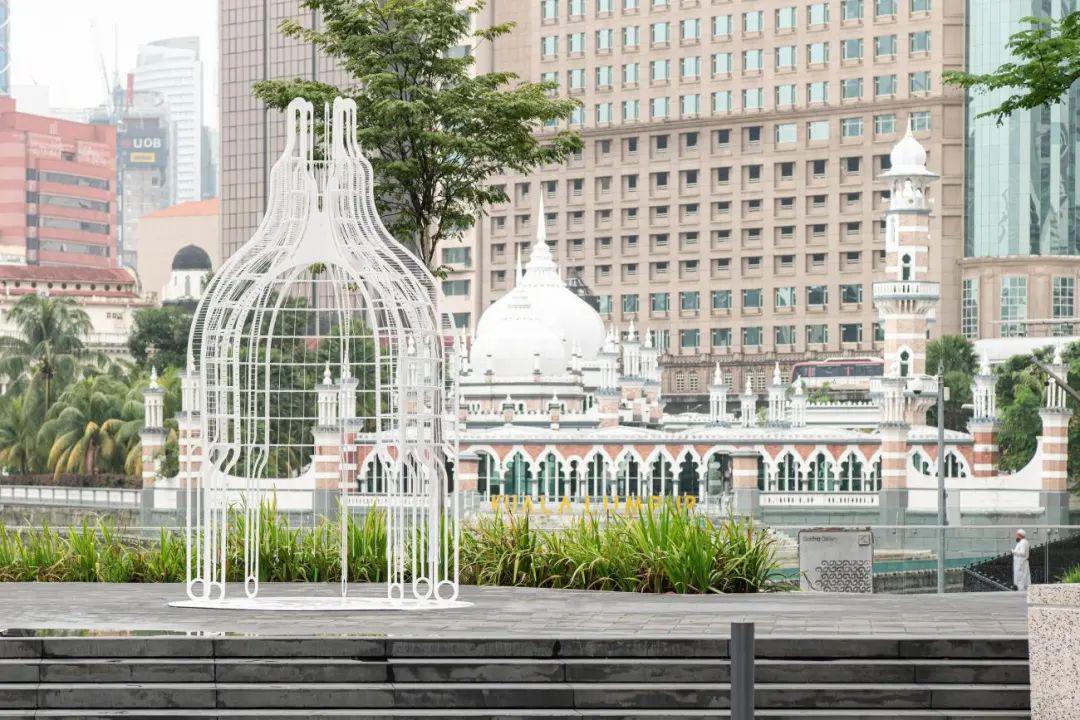在马来西亚吉隆坡的历史中心,伫立着由Pamela Tan设计的Dome of Disappearance,这是一个斜切的骨灰龛结构,记录了周围城市正在消失的遗产元素。从苏联建筑师亚历山大·布罗茨基(Alexander Brodsky)和伊利亚·乌特金斯(Ilya Utkins)的《骨灰龛建筑》(Columbarium Architecturae)(莫斯科一座因快速工业化项目而消失的骨灰龛建筑作品)的启发下,Pamela Tan将该设计构思移植到21世纪的吉隆坡——一个遵循自己独特的现代化愿景的城市背景下。
在马来西亚吉隆坡的历史中心,伫立着由Pamela Tan设计的Dome of Disappearance,这是一个斜切的骨灰龛结构,记录了周围城市正在消失的遗产元素。从苏联建筑师亚历山大·布罗茨基(Alexander Brodsky)和伊利亚·乌特金斯(Ilya Utkins)的《骨灰龛建筑》(Columbarium Architecturae)(莫斯科一座因快速工业化项目而消失的骨灰龛建筑作品)的启发下,Pamela Tan将该设计构思移植到21世纪的吉隆坡——一个遵循自己独特的现代化愿景的城市背景下。
Right in the historic heart of Kuala Lumpur, Malaysia, stands Pamela Tan’s Dome of Disappearance, a columbarium slash structural archive of the disappearing heritage elements of the city around it. Drawing inspiration from Soviet architect Alexander Brodsky and Ilya Utkins’ Columbarium Architecturae (a paper architecture work of a columbarium for “disappearing buildings” in Moscow lost to the project of rapid industrialisation), Tan has transplanted the idea into the context of 21st-century Kuala Lumpur — a city following its own unique modernising vision.



雕塑的造型象征着骨骼、易碎的和转瞬即逝的东西:它的形状灵感来自历史悠久的苏丹阿卜杜勒萨马德贾梅克清真寺(Masjid Jamek)的影子,该清真寺位于吉隆坡交汇处的圆顶背景中,城市有其根源。汇合处和清真寺(该市最古老的清真寺之一,可追溯到1909年)已经有些不合时宜地坐落在笼罩在笼罩着它们的混凝土丛林中,而圆顶的加入及其幽灵般的白色光泽和极简主义美学与城市不断变化的景观形成了鲜明的对比。圆顶由激光切割的金属和棉线沿着其结构编织而成。棉线在风中沙沙作响时,末端松散地解开,让人觉得穹顶也随时会随风而去。
The sculptural form suggests something skeletal, fragile, and evanescent: its shape is inspired by the shadow cast by the city’s historic Sultan Abdul Samad Jamek Mosque (Masjid Jamek), which stands in the background of the Dome at its location at Kuala Lumpur’s confluence where the city has its roots. The confluence and the mosque (one of the city’s oldest, dating back to 1909) already sit somewhat anachronistically amidst the concrete jungle looming over them, and the addition of the Dome with its ghostly white sheen and minimalist aesthetic creates another provocative contrast to the city’s shifting landscape. The Dome is created with laser-cut metal and cotton thread woven interstitially along its structure. The cotton threads unravel loosely at their ends as they rustle in the wind, evoking a sense of ephemerality — as if the Dome too may soon be blown off along the winds of change.



▽结构内部的棉线

Tan's Dome比它的名字所蕴含的意义更乐观,因为它以骨灰龛为设计理念,用以容纳吉隆坡快要消失但尚未消失的元素,旨在是突出存档、记忆和呈现我们周围发生的变化。
Tan’s Dome is more optimistic than its name suggests, because it is a pre-emptive columbarium to house elements of Kuala Lumpur that are at risk of disappearing but have not disappeared yet, with the aim of highlighting the urgent tasks of archiving, remembering, and being present to the changes happening around us.


为此,Tan计划在四个月的时间内对圆顶进行三阶段的改造方法,使其与自然和人文的气质共同蜕变。在繁华的城市中,圆顶最初是作为一个静止的结构对象竖立起来的 ,有意呈现出一种未完成的形态。在第二阶段,公众被授予使用圆顶作为骨灰龛的自主权,在公共瑜伽和素描课程中用他们对吉隆坡的记忆进行描绘,以填充这座“空架子”。然后,它演变成一个安全的空间,公众通过在其间隙编织植物再次参与其中,这是一种抵抗和团结的姿态,反对现代主义蚕食人们一直以来生活的热带雨林。
To this end, she planned a three-phase transformational approach for the Dome over a period of four months, allowing it to metamorphose alongside natural and human temperament. Within the bustling city, the Dome was first erected as a still structural object — deliberately unfinished. In its second phase, the public were granted the autonomy to use the Dome as a columbarium by filling its “empty shelves” with their sketched memories of Kuala Lumpur in a communal yoga and sketch session. Then, it evolved into a safe space as the public again were engaged to weave plants through its interstices, a gesture of resistance and solidarity against modernism’s enforced disappearance of our rainforests.


▽公众通过素描他们对吉隆坡的记忆填充该结构的框架


在吉隆坡市中心,一个高度可见和人口稠密的地区,在这里,现代主义进程带来的的后果一览无遗,这就是Pamela Tan的消失圆顶所选择的场地。凭借其包含的大众记忆,以及其精致而富有意义的形态,它作为对逝去的城市的一种控诉而存在。通过它自身的结构性虚无,作为倾诉对现代主义的集体焦虑的容器,它是为数不多的将人类存在建立在创造性而不是破坏性目的的行为之一。
Within a highly visible and populated area in the centre of Kuala Lumpur where the consequences of modernism can be seen at full force, that is where Pamela Tan’s Dome of Disappearance sits. With its crowdsourced memories, followed by small but meaningful corrective gestures, it acts as an indictment and a safe space. Through its own generous structural nothingness serving as a vessel for confiding collective anxieties about modernism, it is one of the few acts establishing human presence towards a creative rather than destructive end.

Artist/designer: Pamela Tan Poh Sin
Company: Poh Sin Studio
Project Title: Dome of Disappearance
Project Date: October 2019- February 2020 (Temporary Installation)
Organizer: The Cultural Economy Development Agency (CENDANA)
Curator: Snow Ng Advisory & Projects
Workshop 1: Align Self and The City(yoga and sketch) by Wen Yee Kok
Workshop 2: A Plant with a weave (Macrame and pot planting) by Zan Nureen and Farah Fadzil
Photographer: David Yeow
Profile info/contact
Website: http://pohsinstudio.com/
Instagram: https://www.instagram.com/pohsin_studio/
Facebook: https://www.facebook.com/pamelatanpohsin/
Email: Pamelatan.pss@gmail.com
